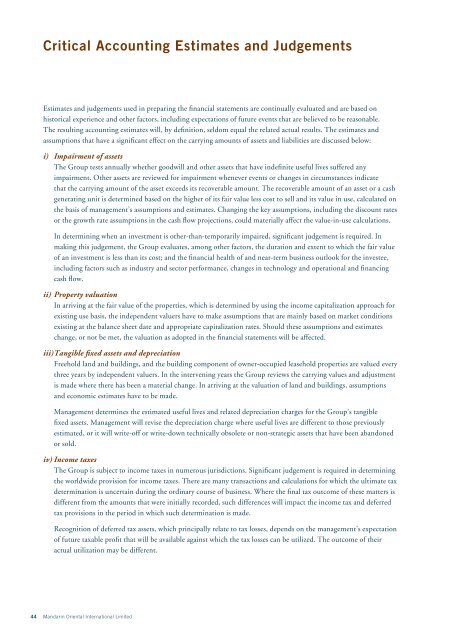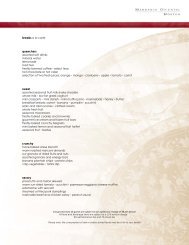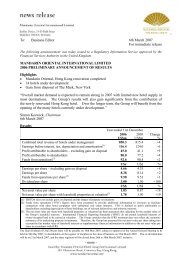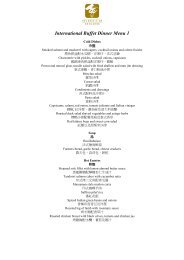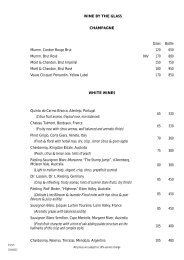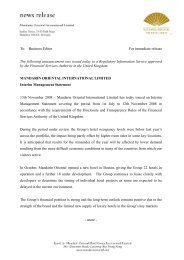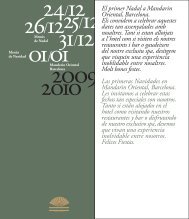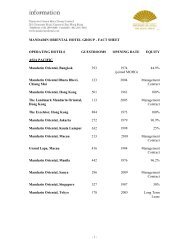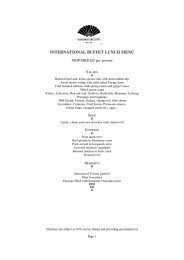Mandarin Oriental International Limited - Mandarin Oriental Hotel ...
Mandarin Oriental International Limited - Mandarin Oriental Hotel ...
Mandarin Oriental International Limited - Mandarin Oriental Hotel ...
Create successful ePaper yourself
Turn your PDF publications into a flip-book with our unique Google optimized e-Paper software.
Critical Accounting Estimates and Judgements<br />
Estimates and judgements used in preparing the financial statements are continually evaluated and are based on<br />
historical experience and other factors, including expectations of future events that are believed to be reasonable.<br />
The resulting accounting estimates will, by definition, seldom equal the related actual results. The estimates and<br />
assumptions that have a significant effect on the carrying amounts of assets and liabilities are discussed below:<br />
i) Impairment of assets<br />
The Group tests annually whether goodwill and other assets that have indefinite useful lives suffered any<br />
impairment. Other assets are reviewed for impairment whenever events or changes in circumstances indicate<br />
that the carrying amount of the asset exceeds its recoverable amount. The recoverable amount of an asset or a cash<br />
generating unit is determined based on the higher of its fair value less cost to sell and its value in use, calculated on<br />
the basis of management’s assumptions and estimates. Changing the key assumptions, including the discount rates<br />
or the growth rate assumptions in the cash flow projections, could materially affect the value-in-use calculations.<br />
In determining when an investment is other-than-temporarily impaired, significant judgement is required. In<br />
making this judgement, the Group evaluates, among other factors, the duration and extent to which the fair value<br />
of an investment is less than its cost; and the financial health of and near-term business outlook for the investee,<br />
including factors such as industry and sector performance, changes in technology and operational and financing<br />
cash flow.<br />
ii) Property valuation<br />
In arriving at the fair value of the properties, which is determined by using the income capitalization approach for<br />
existing use basis, the independent valuers have to make assumptions that are mainly based on market conditions<br />
existing at the balance sheet date and appropriate capitalization rates. Should these assumptions and estimates<br />
change, or not be met, the valuation as adopted in the financial statements will be affected.<br />
iii) Tangible fixed assets and depreciation<br />
Freehold land and buildings, and the building component of owner-occupied leasehold properties are valued every<br />
three years by independent valuers. In the intervening years the Group reviews the carrying values and adjustment<br />
is made where there has been a material change. In arriving at the valuation of land and buildings, assumptions<br />
and economic estimates have to be made.<br />
Management determines the estimated useful lives and related depreciation charges for the Group’s tangible<br />
fixed assets. Management will revise the depreciation charge where useful lives are different to those previously<br />
estimated, or it will write-off or write-down technically obsolete or non-strategic assets that have been abandoned<br />
or sold.<br />
iv) Income taxes<br />
The Group is subject to income taxes in numerous jurisdictions. Significant judgement is required in determining<br />
the worldwide provision for income taxes. There are many transactions and calculations for which the ultimate tax<br />
determination is uncertain during the ordinary course of business. Where the final tax outcome of these matters is<br />
different from the amounts that were initially recorded, such differences will impact the income tax and deferred<br />
tax provisions in the period in which such determination is made.<br />
Recognition of deferred tax assets, which principally relate to tax losses, depends on the management’s expectation<br />
of future taxable profit that will be available against which the tax losses can be utilized. The outcome of their<br />
actual utilization may be different.<br />
44 <strong>Mandarin</strong> <strong>Oriental</strong> <strong>International</strong> <strong>Limited</strong>


